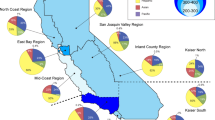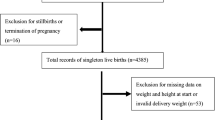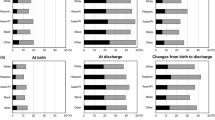Abstract
Objectives
To examine the racial differences in the population attributable fraction (PAF) of prepregnancy obesity and excessive gestational weight gain to large-for-gestational-age (LGA) neonates.
Methods
We conducted a population-based retrospective cohort study among all women who had prenatal screening and had a singleton live birth in a hospital (1 April 2016–31 March 2017) using data from Ontario birth registry in Canada. We used multivariable log-binomial regression models to estimate the PAF and 95% confidence interval (CI) of LGA neonates due to prepregnancy obesity and excessive gestational weight gain. All models were stratified by race (White, Asian, and Black).
Results
Of the 74,402 eligible women, the prevalence of prepregnancy obesity, excessive gestational weight gain, and LGA neonate was 21.1%, 60.0%, and 11.3%, respectively, for Whites; 9.3%, 45.9%, and 5.4%, respectively, for Asians; and 28.6%, 52.4%, and 7.9%, respectively, for Blacks. The association of prepregnancy obesity was greater than that of excessive gestational weight gain on LGA for all racial groups. Excessive gestational weight gain contributed more than prepregnancy obesity in Whites (PAF 32.9%, 95% CI [30.3–35.5%] and 16.6%, 95% CI [15.3–17.9%], respectively, for excessive gestational weight gain and prepregnancy obesity) and in Asians (PAF 32.1%, 95% CI [27.2–36.7%] and 11.8%, 95% CI [9.5–14.1%], respectively, for excessive gestational weight gain and prepregnancy obesity). Prepregnancy obesity (PAF 22.8%, 95% CI [17.1–28.1%]) and excessive gestational weight gain (PAF 20.1%, 95% CI [4.7–33.0%]) contributed to LGA neonates almost the same in Blacks.
Conclusions
Excessive gestational weight gain contributed more to LGA neonates than prepregnancy obesity in Whites and Asians, while there was no difference between excessive gestational weight gain and prepregnancy obesity in their contributions to the LGA neonates in Blacks. The differences are mostly driven by the differential prevalence of the two risk factors across racial groups.
This is a preview of subscription content, access via your institution
Access options
Subscribe to this journal
Receive 12 print issues and online access
$259.00 per year
only $21.58 per issue
Buy this article
- Purchase on Springer Link
- Instant access to full article PDF
Prices may be subject to local taxes which are calculated during checkout



Similar content being viewed by others
Data availability
The data analyzed during this study are held securely at the prescribed registry BORN Ontario. Data sharing regulations prevent these data from being made available publicly due to the personal health information in the datasets. Enquiries regarding BORN data must be directed to BORN Ontario (Science@BORNOntario.ca).
Code availability
The analysis code for adjusted population attributable faction could be available in Appendix B.
References
Siega-Riz AM, Viswanathan M, Moos MK, Deierlein A, Mumford S, Knaack J, et al. A systematic review of outcomes of maternal weight gain according to the Institute of Medicine recommendations: birthweight, fetal growth, and postpartum weight retention. Am J Obstet Gynecol. 2009;201:339.e1–14.
Ouzounian JG, Hernandez GD, Korst LM, Montoro MM, Battista LR, Walden CL, et al. Pre-pregnancy weight and excess weight gain are risk factors for macrosomia in women with gestational diabetes. J Perinatol. 2011;31:717–21.
Goldstein RF, Abell SK, Ranasinha S, Misso M, Boyle JA, Black MH, et al. Association of gestational weight gain with maternal and infant outcomes: a systematic review and meta-analysis. J Am Med Assoc. 2017;317:2207–25.
Weissmann-Brenner A, Simchen MJ, Zilberberg E, Kalter A, Weisz B, Achiron R, et al. Maternal and neonatal outcomes of large for gestational age pregnancies. Acta Obstet Gynecol Scand. 2012;91:844–9.
Headen I, Mujahid MS, Cohen AK, Rehkopf DH, Abrams B. Racial disparities in inadequate gestational weight gain differ by pre-pregnancy weight. Matern Child Health J. 2015;19:1672–86.
Kinnunen TI, Waage CW, Sommer C, Sletner L, Raitanen J, Jenum AK. Ethnic differences in gestational weight gain: a population-based cohort study in Norway. Matern Child Health J. 2016;20:1485–96.
Pawlak MT, Alvarez BT, Jones DM, Lezotte DC. The effect of race on gestational weight gain. J Immigr Minor Heal. 2015;17:325–32.
Bahadoer S, Gaillard R, Felix JF, Raat H, Renders CM, Hofman A, et al. Ethnic disparities in maternal obesity and weight gain during pregnancy—the generation R study. Eur J Obstet Gynecol Reprod Biol. 2015;193:51–60.
Bowers K, Laughon SK, Kiely M, Brite J, Chen Z, Zhang C. Gestational diabetes, pre-pregnancy obesity and pregnancy weight gain in relation to excess fetal growth: variations by race. Diabetologia. 2013;56:1263–71.
Hunt KJ, Alanis MC, Johnson ER, Mayorga ME, Korte JE. Maternal pre-pregnancy weight and gestational weight gain and their association with birthweight with a focus on racial differences. Matern Child Health J. 2013;17:85–94.
Rückinger S, Von Kries R, Toschke AM. An illustration of and programs estimating attributable fractions in large scale surveys considering multiple risk factors. BMC Med Res Methodol. 2009;9:1–6.
McDonald SD, Woolcott C, Chapinal N, Guo Y, Murphy P, Dzakpasu S. Interprovincial variation in pre-pregnancy body mass index and gestational weight gain and their impact on neonatal birth weight with respect to small and large for gestational age. Can J Public Heal. 2018;109:527–38.
Dzakpasu S, Fahey J, Kirby RS, Tough SC, Chalmers B, Heaman MI, et al. Contribution of prepregnancy body mass index and gestational weight gain to adverse neonatal outcomes: population attributable fractions for Canada. BMC Pregnancy Childbirth. 2015;15:1–12.
Kim SY, Sharma AJ, Sappenfield W, Wilson H. Association of maternal body mass index, excessive weight gain, and gestational diabetes mellitus with large-for- gestational-age births. Obstet Gynecol. 2015;123:737–44.
Statistics Canada. Immigration and ethnocultural diversity: key results from the 2016 Census. The Daily. 2017. p. 1–8.
Dunn S, Bottomley J, Ali A, Walker M. 2008 Niday perinatal database quality audit: report of a quality assurance project. Chronic Dis Inj Can. 2011;32:21–32.
BORN Ontario. BORN Data Quality Report 2012–2014—Executive Summary. 2016. http://datadictionary.bornontario.ca/assets/documents/Data%20Quality/BORN%20Data%20Quality%20Report%202012-2014%20-%20Executive%20Summary.pdf.
BORN Ontario. Data Analysis for Annual Report 2014–2016. 2016. https://www.bornontario.ca/assets/documents/Annual%20report%202014-2016%20-%20Data%20Slides.pdf.
Kramer MS, Platt RW, Wen SW, Joseph KS, Allen A, Abrahamowicz M. A new and improved population-based Canadian reference for birth weight for gestational age. Pediatrics. 2001;108:110–3.
World Health Organization. BMI classification. 2019. http://apps.who.int/bmi/index.jsp?introPage=intro_3.html. Accessed 7 April 2019.
Health Canada. Prenatal nutrition guidelines for health professionals: gestational weight gain. 2010. p. 1–19.
Rothman K, Greenland S, Lash T. Modern epidemiology. 3rd ed. Philadelphia, PA: Lippincott Williams & Wilkins; 2008.
US Census Bureau. 2016. https://www.census.gov/quickfacts/fact/table/US/PST045217. Accessed 24 January 2019.
Vickers J, Annette I. Immigration Policy and Multiculturalism. In The Politics of Race: Canada, the United States, and Australia. Toronto, Buffalo, London: University of Toronto Press; 2012. Accessed 17 Feb 2020.
Attewell P, Kasinitz P, Dunn K. Black Canadians and Black Americans: racial income inequality in comparative perspective. Ethn Racial Stud. 2010;33:473–95.
McKinnon B, Yang S, Kramer MS, Bushnik T, Sheppard A, Kaufman JS. Comparison of black–white disparities in preterm birth between Canada and the United States. Can Med Assoc J. 2016;188:13–4.
Yi SS, Kwon SC, Wyatt L, Islam N, Trinh-Shevrin C. Weighing in on the hidden Asian American obesity epidemic. Prev Med. 2015;73:6–9.
Leonard SA, Petito LC, Stephansson O, Hutcheon JA, Bodnar LM, Mujahid MS, et al. Weight gain during pregnancy and the black-white disparity in preterm birth. Ann Epidemiol. 2017;27:323–8.
Flegal KM, Panagiotou OA, Graubard BI. Estimating population attributable fractions to quantify the health burden of obesity. Ann Epidemiol. 2015;25:201–7.
Rockhill B, Newman B, Weinberg C. Use and misuse of population attributable fractions. Am J Public Health. 1998;88:15–9.
Urquia ML, Babaran-Henfrey K, Berger H, Bismilla S, Bocking A, Booth M, et al. Risk of adverse outcomes among infants of immigrant women according to birth-weight curves tailored to maternal world region of origin. Can Med Assoc J. 2015;187:E32–40.
Sgro M, Mamdani MM, Glazier RH, Hilliard R, Urquia ML, Bocking A, et al. Birth weight curves tailored to maternal world region. J Obstet Gynaecol Can. 2016;34:159–71.
Kim S, England L, Sappenfield W, Wilson H, Bish C, Salihu H, et al. Racial differences in the percentage of gestational diabetes mellitus cases attributable to overweight and obesity, Florida, 2004–2007. Prev Chronic Dis. 2012;9:2012.
Robinson E. Overweight but unseen: a review of the underestimation of weight status and a visual normalization theory. Obes Rev. 2017;18:1200–9.
Dzakpasu S, Duggan J, Fahey J, Kirby RS. Estimating bias in derived body mass index in the maternity experiences survey. Heal Promot Chronic Dis Prev Can Res Policy Pract. 2016;36:185–93.
Natamba BK, Sanchez SE, Gelaye B, Williams MA. Concordance between self-reported pre-pregnancy body mass index (BMI) and BMI measured at the first prenatal study contact. BMC Pregnancy Childbirth. 2016;16:1–8.
Bannon AL, Waring ME, Leung K, Masiero JV, Stone JM, Scannell EC, et al. Comparison of self-reported and measured pre-pregnancy weight: implications for gestational weight gain counseling. Matern Child Health J. 2017;21:1469–78.
Holland E, Simas TAM, Curiale DKD, Liao X, Waring ME. Self-reported pre-pregnancy weight versus weight measured at first prenatal visit: Effects on categorization of pre-pregnancy body mass index. Matern Child Health J. 2013;17:1872–8.
Acknowledgements
This study was supported by a Canadian Institutes of Health Research (CIHR) grant (Number FDN-148438).
Author information
Authors and Affiliations
Corresponding authors
Ethics declarations
Conflict of interest
The authors declare that they have no conflict of interest.
Ethical approval
This study received ethical approvals from the Children’s Hospital of Eastern Ontario Research Ethics Board (16/119X) and the Ottawa Health Science Network Research Ethics Board (20160780-01H).
Additional information
Publisher’s note Springer Nature remains neutral with regard to jurisdictional claims in published maps and institutional affiliations.
Supplementary information
Rights and permissions
About this article
Cite this article
Guo, Y., Miao, Q., Huang, T. et al. Racial differences in contribution of prepregnancy obesity and excessive gestational weight gain to large-for-gestational-age neonates. Int J Obes 44, 1521–1530 (2020). https://doi.org/10.1038/s41366-020-0543-5
Received:
Revised:
Accepted:
Published:
Issue Date:
DOI: https://doi.org/10.1038/s41366-020-0543-5



